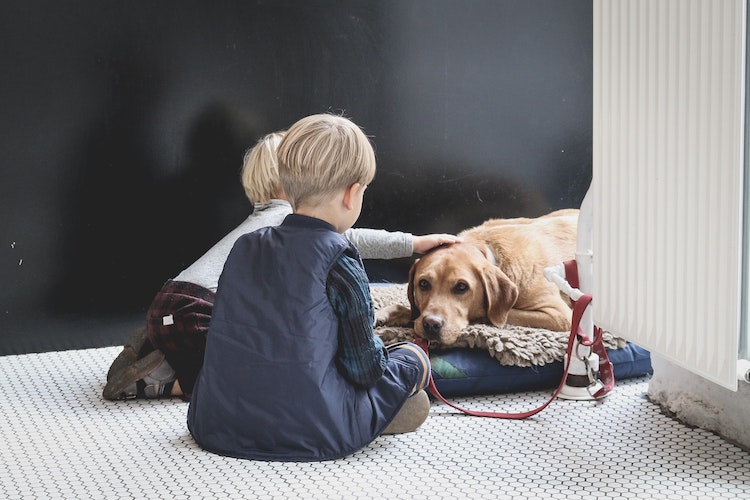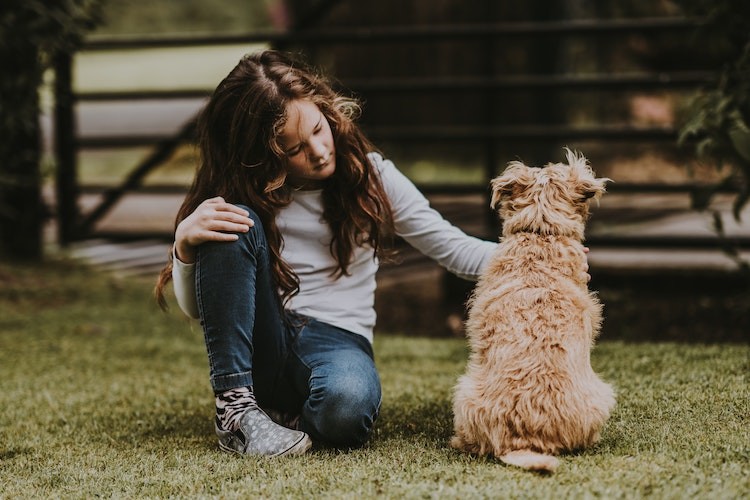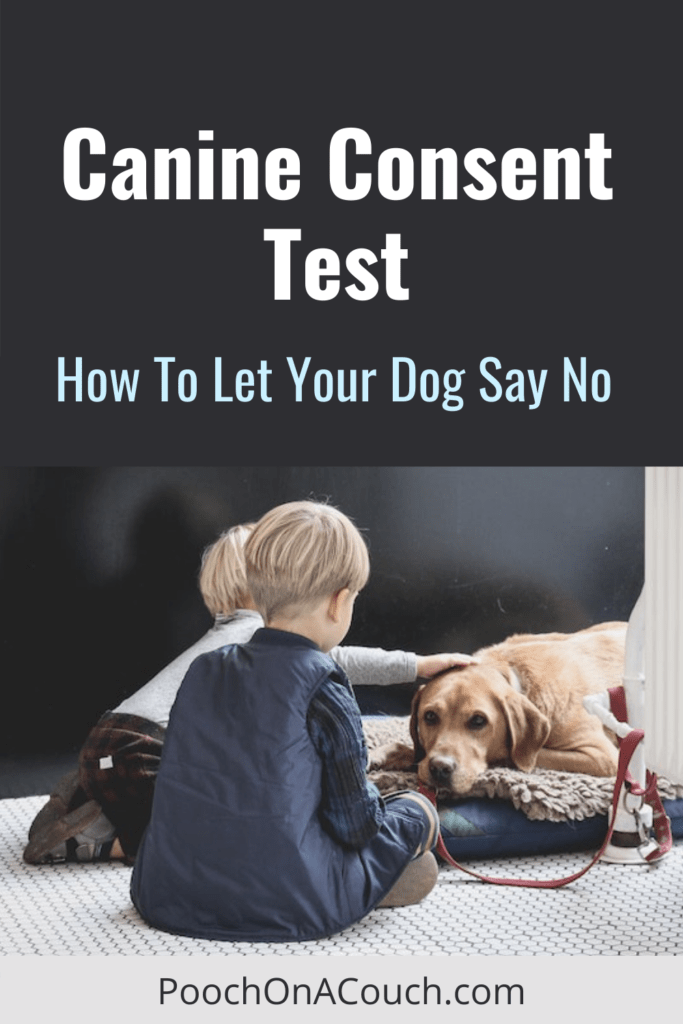How can you tell if a dog wants to be petted? How do you know?
My most recent foster dog, Carter, is a dog that snapped at a few unfamiliar people when being petted. He would act like he wanted the attention at first. He fostered with me for 16 months, and I sure wish I knew about the Canine Consent Test before now!
How did I not know about this test before now? It’s not really a “test”, and you don’t need any advanced education or certification to conduct the test. You just need to know the steps and what to watch for.
I am not a veterinarian nor an animal behaviorist. I present my understanding of health or behavior issues based on personal experience and research I’ve done. If you have a dog with a health or behavioral issue, seek professional guidance. I hope you find my post useful.

Knowing what I know now, this seemingly sweet photograph of a dog with two young children makes me very nervous. Can you spot all the stressors in this photograph? Finish reading, and then come back and see if you see anything new you didn’t see before!
Always Get Professional Advice When You Feel You Need Help With A Foster Dog
Recently, I took my foster dog, Carter, to the training facility that helps me from time to time when I need a new set of eyes on a particular behavior.
Carter, on occasion, would snap at unfamiliar people who were petting him after he’d approached them enthusiastically. Sometimes he’d snap at them rather quickly, and other times, it was after a few minutes of continuous petting. In every situation but one, Carter had the freedom to move away, but didn’t.
I was getting ready to place Carter with adopters and knew I needed to understand this behavior pretty quickly. Thankfully, Carter’s “snaps” were truly snaps – he’d never broken skin or caused a bruise. If he were delivering an injurious bite, my concerns would be different.
I wanted to know why this might be happening, and for sure, what to do about it. Carter’s air snaps come with a snarly growl, sure to frighten new adopters or later, their guests. I needed help.
Meredith took meticulous notes as I described in detail the 6 different incidents where Carter reacted toward strangers. Each situation was mostly unique, but together they gave us a list of triggers where this dog chose to snap at people.
I’ve long known that it is imperative we provide dogs with opportunities to make the right choices – repetition is a predictor. If Carter continued to repeatedly snap at strangers, this behavior would be reinforced and you can bet your sweet bippy it would occur again.
“He’s not unadoptable, I don’t think” she said. “But he needs more training.”
I was settled in my belief that Carter is an adoptable dog, but it was good to hear her say it. Determining a dog to be unadoptable is often a complicated process, outside my skill-set. That said, I do take dog bites – even little ones like Carter’s – very seriously.
I’m an advocate for hiring a credentialed dog behavior consultant any time you are fostering a dog that bites. If you are fostering a dog that has a history of bites that cause injury, the canine consent test may not be something a trainer would advise you to do. Please seek professional guidance.
For more on my take on dog bites, read Just A Dog Bite?
To learn more about dog bite severity, check out Ian Dunbar’s Dog Bite Scale.
The Canine Consent Test
Meredith suggested using a canine consent test with Carter.
I’d never heard of the canine consent test, and I’m not sure its author, but it has been discussed many times by dog trainers everywhere. If you know who penned the canine consent test, please send me a note and tell me, I want to give them credit, ’cause it is brilliant.
The canine consent test is easy to learn.
Once presented with the test instructions, I was surprised at its simplicity. It is so basic, so easy, and so respectful. The trick? getting those “hey, relax – dogs love me!” people to follow directions. You know one, I know you do.
Seriously, there is always going to be some dodo out there who is clueless, persistent, and fast and will be in your dog’s personal space, setting your dog up to fail. It is your job to also be persistent and fast and FIRM. Do not hesitate to say, ‘hey, back it up, friend, I said don’t touch my dog until I say so.”
How To Perform The Canine Consent Test
Ready The Dog
- The dog usually should not be on leash – so take the leash off if you are in an enclosed space such as your home or a fenced yard.
- Do the canine consent test when the dog is relaxed.
- Plan to conduct the test in a space where the dog can freely move about. Don’t put the dog on the sofa or in a crate or in the corner of the room where you are in between them and all exit points.
Ready Yourself
- Put the treats away, you will not need them.
- Make sure you have reviewed canine body language and understand all the various ways a dog can say “no.” This is REALLY important, don’t skip this step.
- Learn the 3-second rule.
- Sit down. Don’t do this test standing up, unless you are working with a giant breed, perhaps. Note if you seem to be towering over the dog; if you are, get lower. For a toy breed, you’d probably need to be on the ground.
- Keep your petting hand neutral and relaxed, resting on your lap or leg.
- Learn to wait. Don’t lure the dog to you with food. But you can call the dog toward you.
Start The Canine Consent Test
- Use one hand, not two when beginning this test. I can use two hands with Carter because he knows me very well, I’d never want an unfamiliar person to do this test with Carter using both hands.
- Open up your hand to the dog, while keeping it resting on your leg or lap.
- When the dog approaches, initiate petting somewhere you think the dog will like.
The chest is usually a good place; the top of the head is a place to avoid at first. Pet using rubs or scratches. Petting using repeat pat-pat-pat can be annoying. Don’t do that. - Watch the dog’s body language as you pet.
- Using the 3-second rule, count out your seconds in half-beats as you pet. “One one-thousand, two one-thousand, three one-thousand.” At two-and-a-half beats, you are thinking/preparing to move your hand away. When you say “three” you should be retracting your hand, putting it back in your neutral position and waiting for the dog to respond.
- If the dog moves toward you or nudges your hand, you can resume petting for another 3 seconds. If they show behaviors that say “No” then stop petting.
In summary, pet for three seconds, then see if your dog is says “Yes, more pets, please!” or ” No” I don’t want any petting right now.

This young girl is down on the ground with the dog, her body position is relaxed, she’s using one hand to pet the dog and it appears she’s rubbing or scratching the dog’s chest, a favorite spot for a lot of dogs. This dog has freedom to move closer or away, depending upon the dog’s consent to pet.
The Results of The Canine Consent Test
Dogs Saying “Yes” I Want More Attention
- The dog moves closer in
- The dog nudges the hand
- You observe relaxed eyes, mouth
Dog Says “No” I Don’t Want More Attention
- Dog makes no behavior change. You might observe that the dog stands or sits still after petting, disengaged.
- The dog physically moves away.
- The dog demonstrates nervous behavior like:
- lip licking
- head turns
- full body turns
- moving away by shifting weight to the back or avoiding the hand
- Dog avoids eye contact.
Dog At First Says “Yes” Then Changes It’s Mind And No Longer Wants To Be Petted
News flash: Dogs can change their mind.
I determined that sometimes, this was Carter’s behavior and why I was so confused by it. Initially, Carter would seek attention, wanted to be petted, but would soon change his mind, I wasn’t paying attention and allowed the petting to continue.
It’s easy but incorrect to think that a dog innately knows it can choose to just walk away.
You know when you join a friend in a social gathering with a group of their friends who’ve known each other for years? And at the end of the meet-up, they all hug and go to hug you, too? Awkward. For me, anyway. I grin and bear it, because extending my arm out in front of me, announcing my personal space is a little rude, I’m told.
If I have a hard time walking out of a hug, I can’t really expect my dog to know how to walk out of a petting session without a little help.
How to help Carter communicate he no longer wants to be petted?
- Repeat the canine consent test often during each petting session. Stop petting after 3 seconds and waiting for a response.
- For Carter, giving the petting a name is similar to learning any behavioral cue. Calling it “lovin’!” + using short periods of petting over time will help Carter come to know that petting will soon end, giving him a choice to continue or walk away.
We did this in the office with Meredith. The first time she stopped petting, Carter went toward her hand and nudged it for more petting, so she gave him another 3 seconds of petting. The second time she stopped petting him, Carter walked away, deciding he wanted to explore her office space for a bit.
Video of The Canine Consent Test
This is one of but a handful of youtube videos available demonstrating a dog-to-human canine consent test. Note how she uses her open hand to invite petting while keeping her hand neutral and to herself. Also note how long she pets the dog before stopping – it’s only a few seconds!
Canine Snuggling Is Not Consent To Pet
Snuggling and petting are two totally different activities to a dog, and Carter drove that point home to me! One of his “bites” occurred after he curled up next to a family member on the sofa. She, being a cat person, began petting him as if he were a cat – head to tail long strokes.
After a couple of minutes, he’d had enough of this persistence, and he loudly snarled and snapped at her. She recoiled her hand – exactly what Carter wanted her to do, STOP PETTING – and then he promptly got down off the sofa. It scared everyone in the room!
It’s exactly the behavior I do not want Carter to rehearse.
So, even if your dog is curled up next to you like it is attached by velcro, still perform a Canine Consent Test. You might find you dog is perfectly happy being with you and not being petted by you.
Did You Know About The Canine Consent Test?
Talk to me! Did you know about the canine consent test? How did you learn about it? How have you used it? Share your stories!

Extra Credit Reading
Does Your Dog REALLY Want To Be Petted? (includes a link to another Canine Consent Test demonstration video.)
Consent: It’s Not Just For People!
How To Be More Fun, Less Annoying, and Avoid Dog Bites
Popular Posts
- HOW TO CHOOSE A DOG RESCUE AGENCY
- ULTIMATE GUIDE TO FOSTERING: 10 SKILLS YOU NEED
- VOLUNTEER IF YOU CANNOT FOSTER




